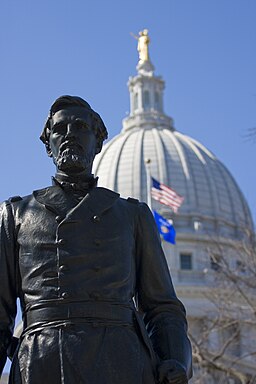Heg was born in Lierbyen in Buskerud, Norway. His parents emigrated to the United States when he was about ten or eleven and settled in Muskego Settlement. At the age of twenty, he got caught up in the California Gold Rush, spending a couple of years prospecting gold before returning to Wisconsin to marry. He joined the Free Soil Party, which was a party devoted to preventing the expansion of slavery into the new territories, and the Republican party when it formed as the national anti-slavery party. He joined a Republican anti-slavery group, the Wide Awakes, who mostly marched in parades and the like, but in Wisconsin did quite a bit more; they forcibly ran slave catchers, who were trying to bring runaway slaves back to the South, out of the area. After Sherman Booth broke a slave out of jail and became a federal fugitive, Heg was the one who hid and sheltered him.
He was also a major in the 4th Wisconsin militia, and when the Civil War began, he was promoted and appointed colonel of the 15th Wisconsin Volunteer Regiment, which was the regiment for Scandinavian immigrants, mostly from Norway. He and his regiment fought at the extremely bloody Battle of Perryville, which the Confederates won, although at sufficient cost that the Union was able to maintain its hold on Kentucky. His regiment had no fatalities despite the intensity of the fighting, but there were quite a few wounded, including Heg himself. He fought again at the Battle of Stones River, neer Murfreesboro, Tennessee, also an extremely bloody battle, with one of the highest casualty counts of the war. Because of his participation in that Union victory, Heg was put in charge of his own brigade, and fought at the Battle of Chickamauga in Georgia. It was a disastrous battle for the Union, and one in which they suffered a very large number of casualties. It was here that Colonel Heg met his end due to a fatal gunshot wound (in the stomach, I believe; it took him nearly a day to die).
The statue in front of the Wisconsin State Capitol that was vandalized was one of the most famous works of the noted sculptor, Paul Fjelde, who was known for his freedom- and progress-themed works. It's probably his second most famous statue, after the bust of Lincoln that was donated to Norway and became the central symbol of anti-Nazi protests in Oslo.
